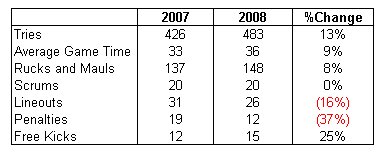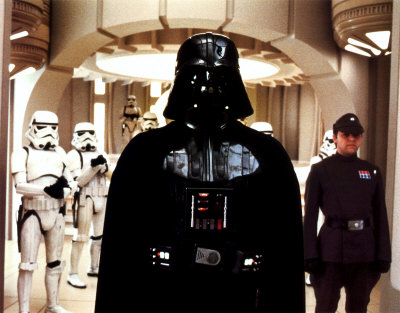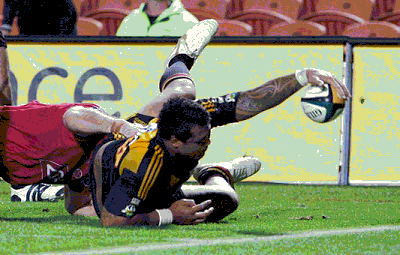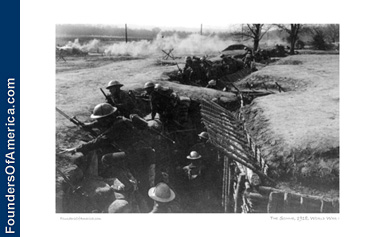The ELVS allow either a fast or slow game.
Please review the post called : Chess vs Checkers
The nature of an ELV game is largely determined by the selections made by the captains on the field. At the breakdown the referee can award an advantage, bent arm penalty, or straight arm penalty. I am not concerned with the more serious infringement of the straight arm penalty as choice of execution by the receiving team is a forced restart. The first two infringements have the option of continual play (a quick tap kick, I considered this to be continual play) or a formal restart via a scrum.
With respect to the advantage, it is most likely that the ball has passed over, and if the awarded team wishes a scrum normally a feeble drop kick attempt or deliberate knock on will force the referee to award bent arm penalty to the team awarded the advantage. The bent arm penalty allows the captain the choice of either a scrum or a tap kick. Therefore it is conceivable that on every advantage or bent arm penalty a scrum can occur if the tactics of the day wish it to be so.
The game of rugby has been built on structured (scrums, kick offs, lineouts, 22 drop outs) and non structured plays (phase play, quick throw in, short lineout). The ELVs have increased non structured play as they allow less stiff arm penalties sourced from the breakdown or scrum. This has proven to be a negative. I do approve with the increased use of bent arm penalties, but this ying needs a yang to balance the game up (see ‘ELVs Please add’ below). I must mention that the short lineout does not qualify as part of the structured game as forwards end up standing in the backs creating a boring line of defense, and what I would call a neutral restart, plus it breaches the ‘Checkers vs Chess’ argument.
It has been the mistake of Super 14 teams to continually select the tap kick each and every time, when it is obvious that either the defensive line is already set or the attacking formation is not ready. This has produced the horrible vision of offensive and defensive lines facing off at each other, very much like rugby league. These lines destroy the structure that rugby was built on, as the forward and backs are formed up by the random order resulting from the last period of play. It is this type of play that no special skill of either the forward or backs is required, a generic loose forward is all that is required for this style rugby. It is here we get the continual and very boring bashing up to the defensive line. This type of play clearly resembles poor tactical sense by the captains and coaches. A better choice is to select a scrum, or a pre set move. An ELV scrum has a further 5 meter clearance and it commits backs and forwards against each other. A pre set move of forwards forming a maul with a quick clearance has it merits. These are better tactical selections and they also maintain the chess game of which rugby union was based (or evolved as).
As mentioned the ELVs have increased the time the ball is in play, by increasing non structured play. The balance between structured and non structured rugby should be re aligned by not allowing short lineouts. This would allow two formal restarts (scrums/lineouts) in rugby when the forwards and backs are completely separated. A short lineouts is basically restarting the game with the horizontal lines of offensive and defensive. Remember the great contest between Walter Little/Frank Bunce and Tim Horan/Jason Little, well with the ELVs this contest has been nearly eliminated from the game as the paring up would most likely be broken by a forward standing in the mix.
So where do I stand. I withhold my verdict until the Super 14 finals. Or maybe after northern teams have had a chance to play with them. I will review major games on this site.
ELV: The bad.
1) Quick throw in. The quick throw in was introduced before the current ELV, the new rule is that the throw in need not be straight, but it can’t forward. Already we have seen the American football style passes to mid field. Come on, must we have this!! Remove the quick throw in completely and give the game a chance to reset. The game is faster with ELV regardless. We just don’t need it as fast as the speed of sound!
2) Advantage Awarded: Why wait for a player to do a failed drop kick, or a deliberate knock on, let the captain say to the referee. Yes we will have a scrum thanks.
3) Never allow a maul to be legally pulled down, (not used in Super 14). If collapsing a scrum is considered unsafe, then so is collapsing a maul, how is this different?
4) Referees, please just rule the game. Now they are teachers, negotiators, opera singers, sorry I preferred it when they where just traffic cops (Ak Murray Mexted). This may not be an ELV, but some how this is new in Super 14.
5) The poor use of advantage and the quick tap (by the awarded team) promotes the horrible vision of neutral horizontal lines of offence and defence. Were the rugby is nothing more than bash it up. The current super rugby ELVs allow more opportunity for this to happen, this is my most server criticism.
ELV: The good
1) Referees have less opportunity to dictate the result of the game thru stiff arm penalties and subsequent kicks at goal.
2) Backs have more space at scrum time.
3) Off side line at the tackle. Clear definition of who should be where.
4) No passing the ball back to 22 to gain distance on the kick out.
5) The management of the breakdown with the emphasis on a bent arm penalty is a welcome improvement. See (1) above.
ELV: Please add.
1) Scrums are a mess. Where has the hooking contest gone? Where has the vertical push test of strength gone? Why allow scrums to screw so much, why are loose forwards consider bound when there wrist is the only part that is attached to the scrum.
2) Bring back legal rucking at the breakdown. See post on rucking.
3) Yellow/Red cards: A player missing from the 15 aside game makes the contest very lop sided and not worth the money paid to view it. I feel that the TV referee should have the final say as to removal of a player. The on field referee can get this so very wrong. The on field referee can put his case to the TV referee, (i.e. warnings given, his view), but the actual incident should be confirmed by the TV referee before any sending off. I would also accept the rugby league method of placing a player on report. This allows the game to continue on as a 15 man contest for a yellow card type offence.
4) No short lineouts. The short lineouts allow forwards to stand in the back line, and this reduces structure from the game. As the ELVs have boosted the occurrence of non structured play, we need to add some structure back into the game by only allowing full lineouts. This gives more opporunity for backs to be backs and forwards to be forwards.
5) Rugby 50/22 Rule. Just as rugby league has a 20/40 rule, rugby union should have a rule that if a kick is made from a teams half and it bounces out in the other teams 22, then kicking team receives the put in. The kick can not be made from a pass back, and must not go out on the full, the bounce need not be in the 22 but the touch line breach must be in the 22. This will reward tactical kicking and force the defending team to have players further back, another way to get players out of the flat defensive line. Also if (4) above is introduced then a full lineout will enable more opportunity for tries from a successful 50/22 kick. I would exclude kick offs and 22 drop outs from this rule. If a team has secured possession thru continual phase play, this rule will allow the game to switch from phase to structured play while allow the attacking team to maintain possession. This has got to be good for the game !
6) The TV referee can examine a try to see from the immediate build up (from the last tackle or structure play) that the ball was in play and there were no forward passes. (ABs vs France RWC quarter finals. Didn’t the referee look stupid, and it would have saved a massive amount of embarrassment for the game on the international stage. The American market would not tolerate such a massive foo-pa !)
I expand on mauls and lineouts in a latter post : ELVs – Endangered Species: Maul and Lineout
To conclude.
Yes I like some of the ELVS, but what I detest the most is the merge of the forwards playing as backs and backs playing as forwards. Then you must ask yourself as a selector, why do you need either, all you need is 15 loose forwards. Don’t get me wrong, this is part of the game and should remain, but it should not be the most prevalent part of it. An even balance is required between structured and non structured play, the current super rugby ELVs have swung the pendulum to far towards non structured play.
The back bone of rugby union is the structure in the game. To allow the specialised skills within the combinations of a rugby side to get more than a fair chance to be exercised on the field. Change or reduce the need for structure then you reduce the need of the specialised skills. And that my friends would be very sad, and a true hybrid of the game would be born.
There should always be a place for the player that is a little slower around the field, that does not look like Dan Carter in his jockeys, who rarely gets a chance to pass the ball in open play, but has immense skill in the scrum, ruck, maul and lineout. (Richard Loe, Carl Hayman, Os Durant, Gary Knight, Andy Haden, any tight forward you can think of !).
I recently watched a super 14 game (round 6) where the Hurricanes played, and the very talented player Conrad Smith (mid field centre) skills were basically not on show as he was rarely matched up with his combination partners (2nd five, wings, full back) during non structured play, as his inside and outside support were tight and loose forwards.
UPDATE1: Consider the arguments for the ELVs (As seen in 2008 Super 14 Rugby)
1) The RWC 2007 finals were boring and lacked tries.
2) The ball is in play longer.
3) It’s a faster more expansive game.
4) There are more tries being scored in super rugby than non ELV years.
5) There are more scrums statistically in the super rugby than non ELV years.
6) It’s a step forward as to making the game easier to understand for a global market.
Before any rule change can be considered, there must first be an examination of the execution of the current rules. Referee interpretations have plagued rugby union, and maybe the issue can be overcome by an improved execution of the current rules.
There is no rugby environment like RWC semi or final rugby, you will not find it in the Tri Nations or Six Nations (Just ask Mr Henry). They are unique within world rugby. It is my feeling that the promotion of non structured rugby (continual phase play) would produce very boring horizontal lines of offence and defense in these very tight games. This type of play does not represent the specialized skill that has evolved within rugby over the last 100 years. Structured rugby has been the base of the some of the greatest tries of all time. There is a place for both structured and non structure rugby, sir it is a question of balance.
It should never be the question of the ‘number of tries’ or the ‘length of time the ball is in play’ or ‘the game is more expansive’, no sir! It should be a question of the quality of rugby play within these statistics. Further the quality of rugby play should be a measured by the execution of the specialized skills of each player involved within the play concerned. Quality first, quantity second, just ask Mr Rolls and Mr Royce!
Yes there are more scrums, and as I understand it there are less lineout’s in this years super 14 rugby. If you find favor with my proposal of only allowing full lineouts and introduce the 50/22 rule (see ‘ELVs Please Add’ discussion above) you will see more lineouts. In there current form lineouts are a bias towards a defense play than attacking, because a short lineout can be selected to allow forwards to stand in the back line. A full lineout is a better base for an attack because the traditional forward and back roles are restored.
Allowing the 50/22 rule in the game would reward the attacking team for an excellent tactical kick, this is better than loosing possession and loosing the opportunity for a follow up attack after such a great kick. This would also encourage the defending team to ensure there are players out of the defensive line to counter such a kick, this surely must promote attack over defense and the tries will follow.
Trying to explain the concept of rugby to (say) an American is the same as been asked to explain cricket. They are both complex, but this is not sound reason to change the rules. Rugby’s ‘confusion richter scale’ can be minimized by finding an even balance of structure and non structured play, assisted by the rules being executed correctly. (Update : Use the chess vs checkers story as a learning tool for the yanks)
Note: My word processor uses and American spell check dictionary, I mean who puts a ‘z’ in minimized, really!
UPDATE2: Review of the Blues (22) vs Crusaders (26) Super 14 Rugby 25-04-2008
Conditions: Dry, good for ball handling. So we must wait as see how a ELV game performs in the deep cold winter, when handling conditions are not so favorable.
The game was very entertaining, but I would still introduce the 50/22 rule and not allow short lineouts as the non structured phase play dominated the playing time (I have written extensively on this imbalance above).
The scrummaging was the downside of the game (and conditions were good, so what will it be like when ground not so good), the continual twisting and players not binding correctly.
The bent arm penalties at the break down is preferred over the stiff arm penalties as the referee has less effect on the score of the game.
To pay for the game (either being there or pay TV) bugs me as a fan to see the game reduced to 15 vs 14 players after the crusaders no 2 was sin binned, why not place the player on report and deal with it after the game, the contest of 15 vs 15 must remain unless extreme foul play has occurred. This is also one of my most server criticisms.
Also,one of the crusaders tries was scored after a player placed his foot on the touch line (as seen on TV, not seen by touch judge), I guess another rugby league precedent can be stolen to look back for infringements (player out, forward pass only) thru third TV referee when a try is scored. Just imagine if this was the RWC final, the game of rugby would be severely embarrassed, as the blues should have won !











